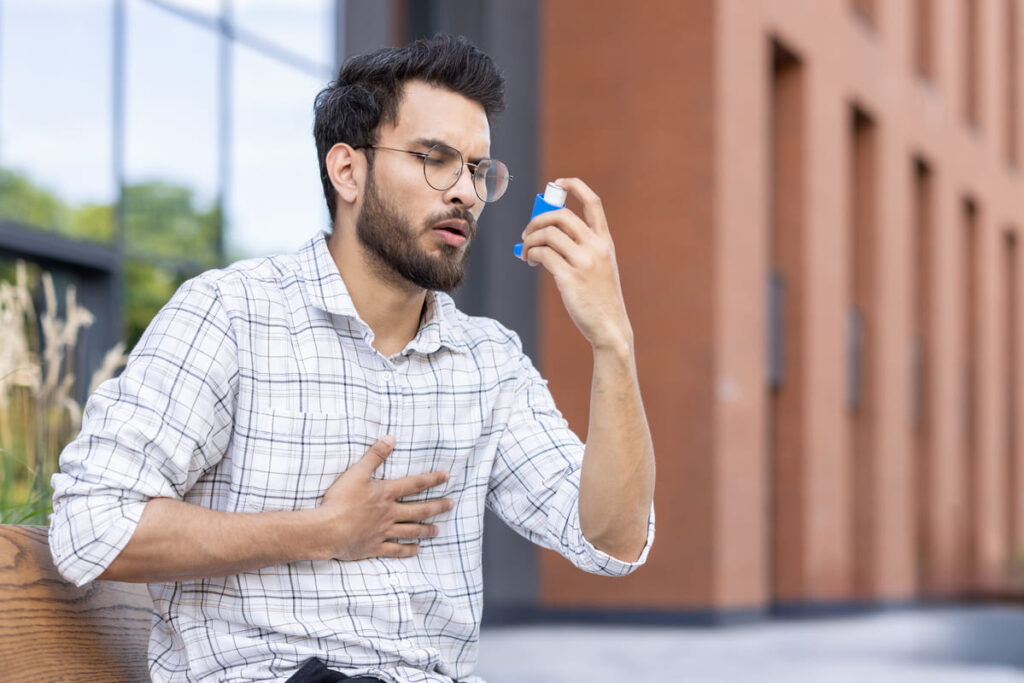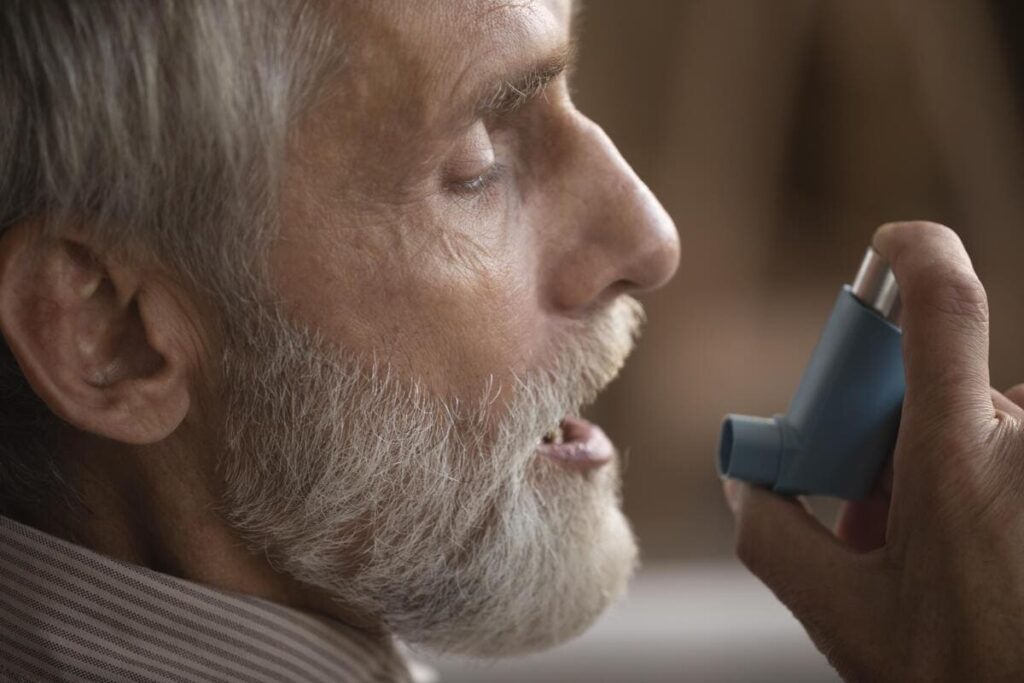Every seven seconds, somewhere in India, a child gasps for air. Every twelve minutes, an adult rushes to an emergency room, fingers clutching an inhaler. Every hour, forty-two people in Bangalore alone struggle with the invisible chains of asthma. This isn’t just about numbers – it’s about the symphony of life, interrupted by the discordant wheeze of inflamed airways. As an Ayurvedic physician watching these statistics climb like our city’s glass towers, I’ve witnessed our ancestors’ ancient wisdom and the stark reality of modern respiratory challenges collide daily in my clinic.

The World Health Organization’s latest data jarred me: over 339 million people globally suffer from asthma, with India bearing one of the heaviest burdens. More sobering still – the respiratory disease unit at St. John’s Medical College reported that Bangalore’s asthma rates have doubled in the past decade, affecting nearly 15% of our city’s children. Yet amidst these troubling numbers, hope rises like the morning mist over our Bangalore lakes. In my twenty-five years of treating respiratory conditions through Ayurveda, I’ve witnessed transformations that modern medicine struggles to explain. This isn’t just ancient wisdom adapting to modern challenges; it’s a time-tested solution finding its place in contemporary healing.
The evidence continues to mount: A systematic review analyzed 32 clinical trials and found that Ayurvedic herbs like Vasaka (Adhatoda vasica) reduced acute asthma episodes by 48% compared to placebo groups. Even more compelling, recent studies highlighted that standardized Ayurvedic interventions, combining specific Ayurvedic medicines with breathing exercises, showed a remarkable 57% improvement in pulmonary function tests across multiple studies.

Like the branches of our beloved rain trees that adapt to changing winds, our ancient Ayurvedic wisdom bends and flexes to meet modern challenges. Today, I want to share my experiences treating asthma through the holistic lens of Ayurveda, complemented by yoga and lifestyle modifications that particularly resonate with our unique Bangalore context.
Last week, a software professional from Electronic City rushed into my clinic, gasping like a pressure cooker, letting off steam. Working late nights, surviving on food delivery, and battling Bangalore traffic had taken their toll. In Ayurveda, we recognize this as Tamaka Shwasa, where both Vata and Kapha doshas are vitiated. However, unlike the Western approach, which often begins and ends with inhalers, our treatment is painted on a broader canvas.

The beauty of Ayurvedic treatment is that various asthma management approaches exist. I have observed three predominant patterns in my practice, each requiring its solution, like different ragas in Carnatic music, which create distinct emotional responses.
Let me share a particularly memorable case demonstrating the power of Ayurvedic intervention combined with lifestyle modifications. A 36-year-old school teacher – whose story perfectly illustrates the impact of Bangalore’s unique climate on respiratory health – arrived at my clinic last year. Recently relocated from Noida, she was struggling with severe nocturnal asthma that had transformed her life into an exhausting cycle of sleepless nights and tired days. Standing before her class of third-graders, she would fight to keep her eyes open, her voice hoarse from nightly coughing fits. As a mother of two young children, her depleting energy levels were taking a toll on both her professional and personal life.
Her dependency on inhalers had reached a concerning level – two to three puffs daily just to maintain basic functionality. The turning point came when we implemented a comprehensive protocol: Vasarishta (15ml twice daily), combined with Kanakasava (15ml after meals), and Swasananda Gulika for acute episodes. However, the magic wasn’t just in the medicines. We meticulously restructured her lifestyle, eliminating common triggers like curd, ice cream, milk products, and sweets. I insisted on wrapping dinner by 7 PM – a challenge she initially resisted but soon embraced.
The results were remarkable. Within three months, she went from reaching for her inhaler multiple times daily to not needing it. Her morning walks on the Veterinary College campus became a daily ritual rather than an exhausting chore. Most significantly, she rediscovered her enthusiasm in the classroom, no longer fighting fatigue. Today, she maintains her wellness through pranayama and lifestyle discipline alone – a testament to how Ayurvedic principles, when followed diligently, can transform chronic respiratory conditions.

Another case that profoundly illustrates the transformative potential of Ayurvedic treatment involved a 45-year-old police officer whose battle with severe asthma had turned his family life upside down. His wife’s description was heartbreaking: “His wheezing could be heard from the next room. Every night, he would sit bolt upright, leaning forward, desperately fighting for each breath.” The midnight drama was painfully familiar to his entire family – the rushed opening of windows, the frantic searches for inhalers, and the emergency drives to Chaitanya Nursing Home for nebulization at least twice weekly.
His condition remained critical despite a transfer from traffic duty to a desk job. Dependent on inhalers 6-7 times daily, his persistent chest tightness led to multiple ECG checks, adding anxiety to his already compromised health. His elevated eosinophil count told the story of his body’s hyperactive response to environmental triggers.
I initiated an intensive Ayurvedic protocol: Shwasa Chintamani Rasa (twice daily), combined with Vardhamana Pippali Yoga in escalating doses, Pushkaramrita (15ml thrice daily), and Shwasananda Gulika for acute episodes. But the real challenge was convincing this tough police officer to give up his favourite triggers—bananas, curd, potato chips, and spicy snacks. “Sir,” I told him, “you have maintained law and order for decades; now it’s time to bring discipline to your health.”
His dedication proved remarkable. He embraced twice-daily pranayama sessions, gradually increased his morning walks from 15 to 50 minutes, and religiously sipped Samahan tea at 6 PM after work. During acute episodes, a simple cup of hot coffee provided surprising relief. The transformation was dramatic – he bid farewell his inhalers within three months. By six months, his colleagues could hardly believe he was the same person who once struggled to climb a single flight of stairs.
Today, he’s become an unexpected health ambassador in his department, passionately sharing his journey with anyone who listens. “This isn’t just about breathing better,” he often says, “it’s about reclaiming your life.” His hard-earned wisdom, born from so many sleepless nights and finally finding relief, now inspires others suffering respiratory challenges.

Recent research from the Department of AYUSH validates what our ancient texts have long proclaimed. A study conducted at a prominent Bengaluru Ayurvedic hospital showed a 60% reduction in acute asthma episodes among patients following a combined protocol of Ayurvedic medicines and yoga. The study particularly highlighted the effectiveness of specific pranayama techniques – Nadi Shodhana and Bhramari – in improving lung function.
Speaking of yoga, let me share a remarkable case from my practice. A retired Air Force officer struggling with chronic asthma transformed his condition through the dedicated practice of Surya Namaskara and specific asanas like Matsyasana and Bhujangasana. “Doctor,” he told me last month, “I feel like my chest has wings now.” His story reminds me of how our city’s lakes, when properly maintained, become breathing spaces for the surrounding neighbourhoods.
For optimal respiratory health, embrace bitter gourd, drumsticks, and cluster beans. These natural bronchodilators work wonders when cooked with immune-boosting garlic and ginger.
Fill your plate with anti-inflammatory pearl millet rotis, barnyard porridge, and red rice ganji. Fish lovers should opt for mackerel and sardines, which are rich in respiratory-supporting omega-3s.
Your spice box is your medicine cabinet: Use black pepper, long pepper, cinnamon, and cardamom liberally in cooking. Favour pomegranates, Indian gooseberries, jamuns, and ripe pineapples, but strictly avoid bananas, watermelon, and cold fruits. For dairy, stick to fresh buttermilk spiced with curry leaves and ginger—avoid curd, cheese, and ice cream entirely.
Now, for immediate relief during mild attacks, here are my most effective home remedies that I have refined over two decades: First, the powerful 4:4:4 breath remedy – inhale for four counts through right nostril, hold for 4, exhale for 4 through left, repeat 4 times. Mix one teaspoon of ajwain seeds with jaggery and keep it under your tongue during an attack. For night-time relief, boil 2-3 cloves of crushed garlic with 4-5 tulsi leaves in water and sip warm. When the chest feels tight, press the thumb knuckle firmly on the hollow point three fingers below your throat for 30 seconds.
Mix equal parts of honey and mulethi powder; take one teaspoon thrice daily during allergy seasons. For morning congestion, heat mustard oil with 2-3 garlic cloves until dark, cool slightly, and gently massage chest and upper back. Keep a thermos of hot ginger-tulsi-mulethi tea handy – sip every two hours during acute episodes. These remedies and tools for self-reliance have helped hundreds of my patients.
Asthma attacks can be life-threatening. Never hesitate to use inhalers or seek emergency care during acute attacks. Ayurveda gradually reduces inhaler dependency—it doesn’t replace emergency medication. Always keep your rescue inhalers handy and work with your pulmonologist and Ayurvedic physician.

Diet plays a crucial role, especially considering Bangalore’s changing food culture. I advise my patients to be like our city’s famous weather – adaptable but consistent. Avoiding cold, heavy, and processed foods is crucial. Instead, focusing on warm, light, easily digestible meals helps maintain balanced doshas. Curd, ice cream, and refrigerated leftovers are like fog on our winter mornings – they create obstacles in the respiratory channels.
Living in Bangalore today means facing unique respiratory challenges. Here’s what works for my patients: Keep windows closed during peak traffic hours (8-10 AM, 5-7 PM). Install air purifiers in bedrooms – they’re an investment in your health.
Use wet mopping instead of dry sweeping. When AQI levels cross 150 (check your weather app daily), wear an N95 mask outdoors. Use a good humidifier to keep indoor humidity between 40% and 50%.
Create a green shield with air-purifying plants—three Snake Plants in your bedroom, two Areca Palms in your living room, and a Money Plant near your work desk can significantly improve indoor air quality. During high-pollution days, shift your morning walk to indoor breathing exercises.
For my patients suffering from anxiety-induced asthma attacks, I often share this analogy: think of your breath like Bangalore traffic – when you try to rush and force your way through, everything gets worse. But when you stay calm and follow the flow, even challenging situations become manageable.
Every morning in Bangalore tells a story: construction dust rises like morning incense, vehicle fumes dance with monsoon mist, and pollen drifts like silent snow from our beloved Gulmohar trees. In my clinic, I watch the city’s breath grow shorter – young techies clutching inhalers, children missing school, elderly couples shifting homes to escape pollution. Yet, I’ve witnessed over two thousand asthma patients transform their lives in this city through Ayurveda’s ancient wisdom. They arrive breathless, desperate, and dependent on nebulizers and steroids. They leave different people – more substantial, calmer, breathing freely. Our classic combinations of Sitopaladi churna, Swarna Sameera Pannaga Rasa, and time-tested formulas don’t just treat symptoms; they rebuild lives.
As Bangalore grows taller, faster, and more crowded, our solutions must grow deeper, wiser, and more rooted. You can not buy air. But you can learn to breathe again. That is what the old medicines teach you. The medicines were bitter, and the city was harsh, but when you could breathe again, none mattered anymore.


1 comment
I need to get rid of the pump too – Please help i will be reaching you soon.